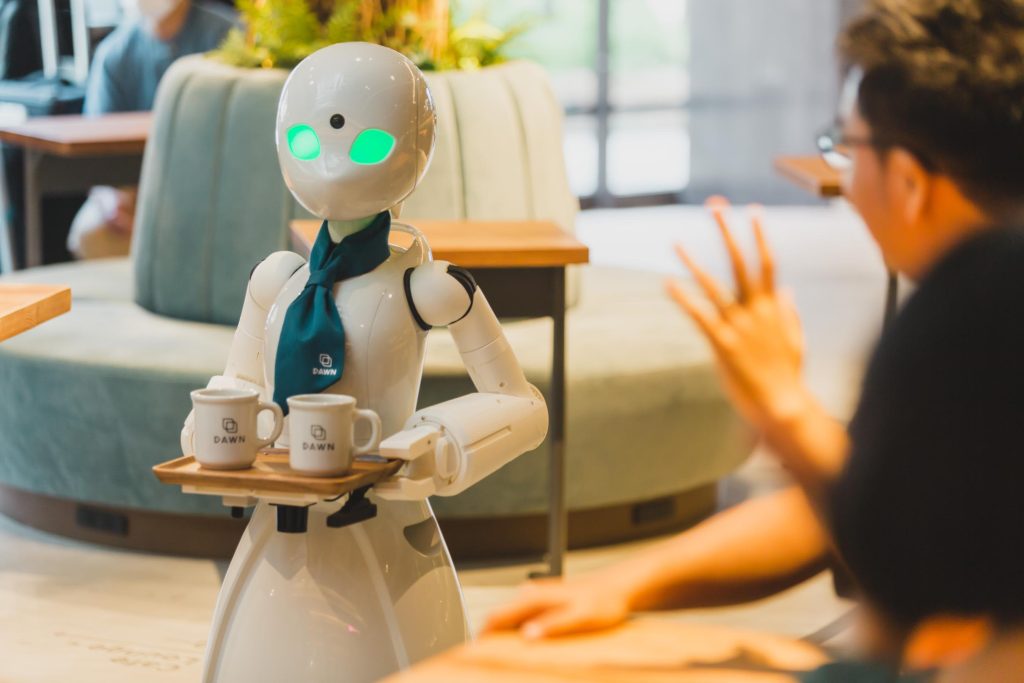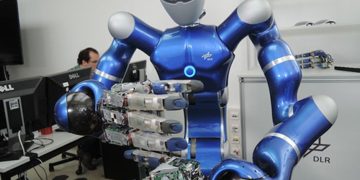I wake up before dawn, as I do every day, and my apartment is already humming with quiet activity. My personal assistant robot, Tiko, has started the coffee, brushed the crumbs off the floor, and reminded me that the first client for the day will arrive at 7:30 AM. I glance at the calendar projected onto the wall by the AR interface above my bed—five service robots scheduled for maintenance, two deliveries, and an emergency call from the hospital. It’s a typical Tuesday in a city where machines and humans coexist in a delicate choreography.
The sun isn’t even up yet, but the streets outside are already alive with the subtle sounds of electric motors, whirring gears, and sensors scanning the urban landscape. As I step outside, I feel the same awe I always do. The robots move seamlessly among people—autonomous street cleaners brushing the sidewalks, delivery bots gliding with crates of fresh bread and groceries, and the familiar blur of self-driving taxis. Every machine has its role, its routine. Every machine is my responsibility in some way.
Morning Route: Hospitals and Homes
My first stop is St. George Hospital. I push my toolbox along the sidewalk as a fleet of courier robots passes me, delivering medication and samples across the city. At the hospital, a humanoid nurse robot named Clara is awaiting my attention. Her left arm’s servo motors are misaligned, causing her to spill water when helping patients.
As I open her maintenance panel, I reflect on the complexity of these machines. People often think of service robots as simple appliances, but they are anything but. Clara has hundreds of sensors, dozens of articulated joints, and an AI brain capable of understanding patient emotions, reminders, and emergency protocols. One misaligned motor might seem trivial, but for a nurse robot, even a slight miscalibration can compromise patient safety.
I tighten the screws, realign the actuators, and run diagnostic protocols. Clara’s eyes light up with the familiar green glow, signaling that she’s operational again. Watching her move flawlessly down the corridor, assisting the elderly, I can’t help but feel a small sense of pride. These machines are extensions of human care—but they are also partners in empathy, programmed to simulate understanding and kindness.
Next, I head to a residential building where the morning cleaning robots have reported anomalies. A robotic vacuum named Orbit has repeatedly collided with furniture, confusing a new layout in one of the apartments. As I step inside, the owner greets me, bleary-eyed but relieved. “It’s amazing how these little things do so much, but when they break, it feels like the house has lost a part of itself,” she says. I nod.
I recalibrate Orbit’s mapping sensors, update the firmware, and let the robot navigate the room for a test run. It glides across the living room, avoiding chairs and coffee tables, its little wheels making barely a sound. There is a subtle elegance in its movement, a reminder that technology can be both functional and graceful.
Afternoon Rush: Retail and Logistics
By noon, I’m at the central distribution hub for a chain of automated convenience stores. Here, dozens of service robots stock shelves, monitor inventory, and guide customers. A complaint has come in from the network: several shelf-scanning robots have been misidentifying items due to a recent software patch.
I dive into the AI logic modules, tracing code paths and sensor inputs. The problem isn’t mechanical; it’s cognitive. The robots interpret barcodes and visual patterns to locate products, but the update introduced a minor bug in object recognition algorithms. Fixing it requires both technical knowledge and patience—AI behaves predictably, but it is not infallible.
As I work, I notice the interaction between human workers and robots. Employees monitor robot activity on screens, occasionally adjusting their schedules to align with the machines. Some customers stop to ask questions, wondering if the robots are “smart enough” to understand them. I smile quietly, knowing the reality: these robots operate within defined parameters, yet their seamless integration into everyday life makes them appear intelligent, almost sentient.
Later, I accompany a fleet of delivery robots on their first test run after maintenance. They traverse crowded sidewalks, avoiding pedestrians, pets, and cyclists. I marvel at the precision of their AI, the way it anticipates human movement, the way it adapts to changing conditions. For every accident avoided, there is a combination of sensors, algorithms, and real-world feedback. It is an intricate dance, invisible to most, but vital to the city’s rhythm.
Evening Calls: Emergencies and Ethical Quandaries
By late afternoon, the city begins to slow, but emergencies never sleep. I receive a call from the nursing home where an assistive robot named Milo has malfunctioned. Milo is designed to support elderly residents in mobility and companionship, a gentle presence for those living alone.
When I arrive, I notice something unusual. Milo’s facial recognition software has misread one resident, triggering repeated alerts. The resident, Mr. Li, is frustrated and anxious. “It’s supposed to help me, but now it scares me,” he complains.
I kneel beside Milo, connecting diagnostic tools to its neural interface. As I debug its recognition algorithm, I reflect on the responsibilities of being a robot technician. We often think in mechanical and computational terms, but these machines affect human emotions. One misinterpretation can cause fear, loneliness, or confusion. The ethical dimension of service robots is inseparable from their physical repair.
As Milo resumes normal function, Mr. Li pats the robot gently. There is a strange kind of intimacy here, a silent acknowledgment that humans and machines are entwined in emotional ecosystems. My work is not just fixing metal and circuits; it is repairing trust, restoring comfort, and maintaining the fragile bond between technology and humanity.

Nightfall: Reflections in the Workshop
By 9 PM, I return to my workshop, exhausted but satisfied. The day has included mechanical repairs, software debugging, ethical problem-solving, and countless small acts of care. I sit among a dozen half-repaired robots, some silently charging, others waiting for software updates.
I reflect on the strange intimacy of my job. Unlike most professions, I am intimately familiar with these machines’ strengths and limitations. I know which sensor fails first, which actuator is most prone to wear, which AI modules tend to misinterpret human emotion. And yet, I also know that my work is never complete. The city depends on robots every hour of every day, and each repair or adjustment ripples through the lives of hundreds of people.
I sip coffee and watch a drone sweep across the skyline through the workshop window. Tomorrow, I will rise again before dawn. The robots will be ready, the streets will hum with activity, and my role will begin anew. It is repetitive, demanding, sometimes lonely—but also profoundly human.
Because in caring for machines, I am reminded of the care they extend to all of us. Every repaired motor, every updated AI module, every calibrated sensor is a promise: the city can function smoothly, people can live with ease, and the quiet revolution of service robotics will continue.
The Philosophy of Repair
As I finally prepare to rest, I consider the paradox: robots are designed to serve humans, yet they require service themselves. Their independence depends entirely on human intervention, yet their performance shapes our dependence on them.
In repairing them, I am engaged in a subtle collaboration. Human intuition guides mechanical precision. Empathy guides algorithmic logic. Patience ensures efficiency. Through this labor, I participate in a larger system, a living ecosystem where humans and machines sustain one another.
And perhaps this is the essence of the modern city: a delicate symbiosis where service is shared, responsibility is distributed, and life flows in quiet, invisible harmony between gears and hearts.
End of the Day: A Symbiotic Future
The repairman’s day ends, but the city does not. Robots continue their patrols, deliveries, and care routines. Tomorrow, I will walk the same streets, fix the same machines, and again observe the quiet miracle of coexistence.
Service robots have become more than tools—they are partners, extensions of human intention, and mirrors of our own desire for efficiency, compassion, and order. The city thrives because of them, but it also thrives because of the humans who care for them.
And in this cycle of care and repair, I find a quiet fulfillment, a reminder that the future is not about machines replacing us—it is about machines enabling us to be more fully human.












































